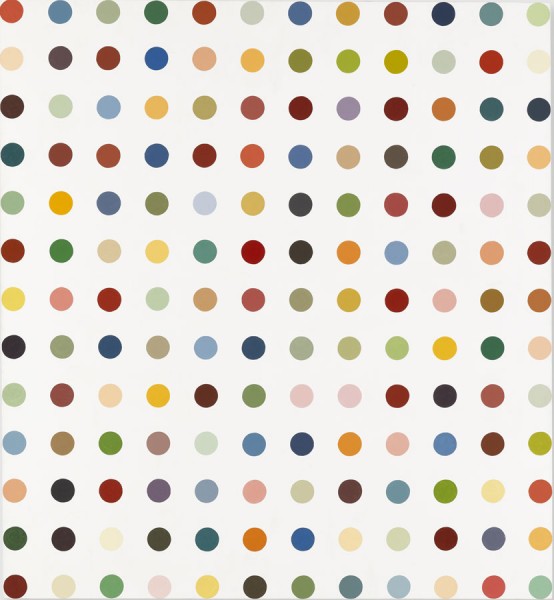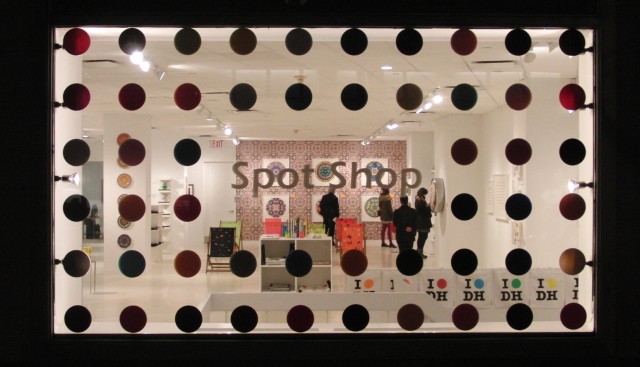Gagosian Gallery
980 Madison Ave., 555 West 24th St., 522 West 21st St.
Through February 18, free
www.gagosian.com
In the 1945 Warner Bros. short Hare Tonic, Bugs Bunny tricks Elmer Fudd into believing that the hilarious hare is infected with Rabbititus. “How do you know I’m contaminated? I haven’t got any symptoms. You don’t see no spots before my eyes, do ya?” Bugs asks as a group of colorful spots swirls in front of his face. Right now at all eleven Gagosian locations around the world — from Hong Kong, Geneva, Beverly Hills, and London to Paris, Rome, Athens, and all three galleries in New York City — people are seeing spots before their eyes, but it has nothing to do with Rabbititus. Instead, the outbreak is the result of Damien Hirst’s “The Complete Spot Paintings 1986-2011,” comprising more than three hundred of the British bad boy’s household gloss on canvas works. Each painting features multiple dots of a single size, hand-painted by a single member of Hirst’s team, with no color repeated. In New York, the spots range from one millimeter to slightly more than one yard each, with most falling in the one-to-six-inch range, in circular patterns or straight up-and-down grids, creating a dizzying array as you make your way through room after room after room. The majority of the works are named after pharmaceutical and chemical products, referencing Hirst’s familiar cabinets filled with pills and other medical paraphernalia; among the titles are “Cefatrizine Propylene,” “Minoxidil,” “Benzoic Anhydride,” “Aminobenzaldehyde,” and “Hexadecanedioic Acid.” Hirst adds extra playfulness to the fifth floor of 980 Madison, with several canvases featuring spots that are barely visible or cut in half, as well as a “Controlled Substance Key Painting” that might or might not offer a way to decipher hidden meanings in the works.
If you look closely, it is easy to see that the arrangements are not perfect, indeed made by humans and not machines. You’ll also notice that just about everyone else in the gallery is smiling, getting a kick out of the seemingly endless display of colorful canvases, which can be cheerful and friendly, warm and welcoming. We are not a bit ashamed to admit that we thoroughly enjoyed our three-gallery jaunt through Hirst’s “Spot Paintings.” Perhaps it was our OCD working overtime, but we were drawn into the aesthetically pleasing, colorful works, excited by the repetition and consistency. So why are so many people unhappy with Hirst and decrying the exhibition as a self-centered display of artistic pomposity and conglomerate excess? Of course, it is impossible to look at the spot paintings and not think about Hirst, Inc. Hirst is big business, and his manipulation of the market for his works has made him a lot of enemies. Yes, there is a small concession in the 24th St. space as well a much bigger Spot Shop up on Madison Ave., where you can buy Hirst tote bags, clocks, stickers, skulls, pins, prints, and various other ephemera. So maybe the spots in front of Hirst’s eyes are made of giant dollar signs — you can practically hear the “ca-ching” as you meander through the galleries — but does the meta surrounding Hirst & Company take away from the sheer pleasure that most people derive from seeing these works? “It was just a way of pinning down the joy of color,” Hirst has said about the spot paintings. We found a whole lot of joy in this show, even if it is a way to make Hirst that much richer as he prepares for his first major museum career survey (beginning in April at the Tate Modern). And as far as Rabbititus goes? Well, you can consider the spots to be little more than hundreds of thousands of rabbit pellets deposited by an egotistical British Easter Bunny. You can think of them as the result of a Warholian cadre of assistants metaphorically screwing like rabbits. Or you can just get a huge kick at the nearly endless joy of color. It’s your choice.

